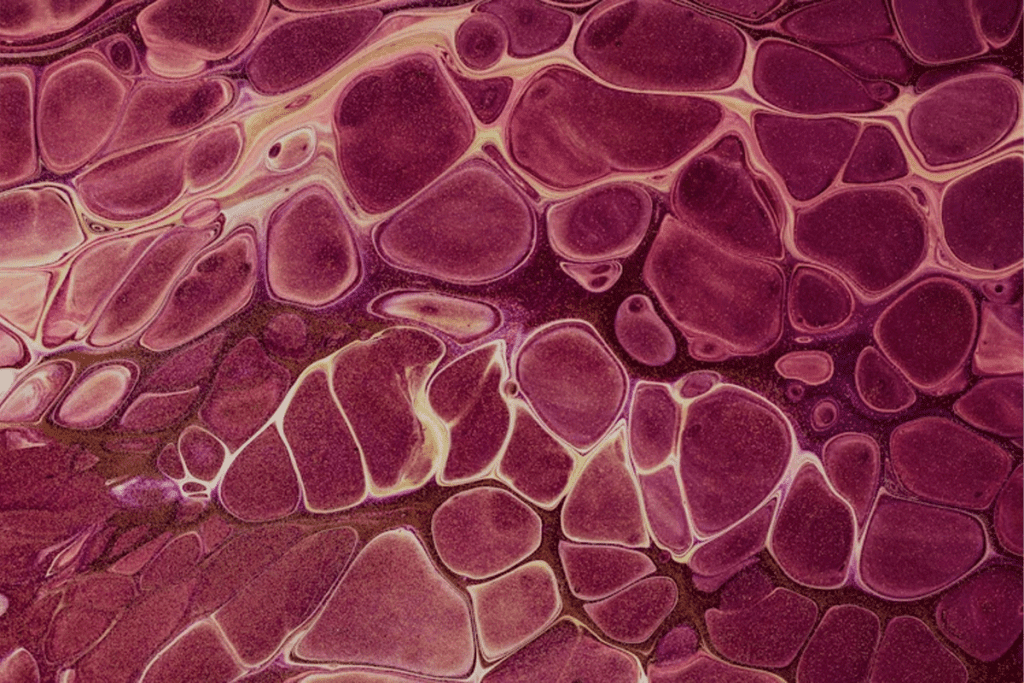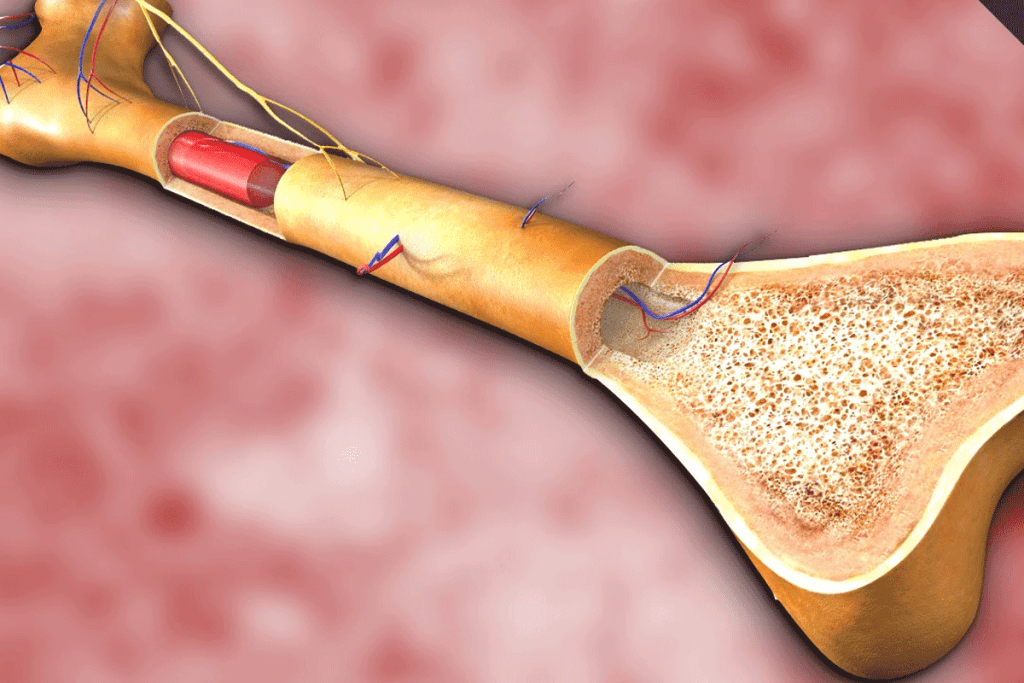Last Updated on October 22, 2025 by mcelik

When we look at adipose-derived stem cells and bone marrow-derived stem cells, we see big differences. Bone Marrow Stem Cells vs Fat Stem Cells both can change the game in stem cell therapy. But, they have unique traits and uses.

Stem cells are key in regenerative medicine, opening up new ways to treat and heal. This field aims to fix or replace damaged cells, tissues, and organs with stem cells. Their special abilities make them perfect for this task.
Stem cells can turn into different types of cells and make more of themselves. They have two main traits: they can keep themselves going and turn into various cells. Their power to heal comes from their ability to:
Stem cells are sorted by how far they can change into different cells. The main types are:

The origin of bone marrow and fat-derived stem cells significantly influences their function and therapeutic potential. Knowing these differences helps us see how they can be used to help people.
Bone marrow stem cells come from the bone marrow, usually from the iliac crest. They can turn into many types of cells, like blood cells. On the other hand, fat stem cells are taken from fat tissue, often during liposuction. They are easy to get and are found in lots of fat tissue.
Bone marrow stem cells can grow and change into many cell types. Fat stem cells, on the other hand, help the body heal and grow new blood vessels.
The ability of stem cells to change into different types of cells is key. Bone marrow stem cells can turn into bone, cartilage, and fat cells. Fat stem cells can also change into different types of cells, but they are best at making fat and bone cells.
How these stem cells can help us depends on their abilities. Bone marrow stem cells are used in treatments for blood disorders. Fat stem cells are being studied for their role in fixing damaged tissues.
In summary, bone marrow and fat stem cells are both useful in different ways. Their origins and what they can do make them valuable for treating various health issues.
Stem cell harvesting has two main methods: bone marrow aspiration and adipose tissue extraction. Knowing how they differ helps decide which is best for different treatments.
Bone marrow aspiration takes bone marrow from the hipbone or sternum. A needle is inserted into the bone marrow, usually under local anesthesia. This method is common for treating blood disorders and boosting the immune system.
The process is complex and needs special training. This can affect how patients feel, including pain, recovery time, and possible side effects.
Adipose tissue extraction removes fat, often through liposuction. It’s less invasive than bone marrow aspiration and can be done under local anesthesia. The fat tissue is then processed to get stem cells for treatments like reconstructive and aesthetic medicine.
Processing the fat involves breaking it down and spinning it to get more stem cells. How well this is done can impact the stem cell quality and amount.
The patient experience differs between the two methods. Bone marrow aspiration is more invasive and can be more painful with longer recovery times. On the other hand, adipose tissue extraction is less invasive, leading to quicker recovery and less pain.
Though rare, complications like infection, bleeding, and reactions to anesthesia can happen. These risks can be lowered by choosing the right patients, skilled doctors, and following clean techniques.
stem cell yield comparison
It’s important to know what affects stem cell yield and viability. This knowledge helps improve the success of stem cell treatments. The success of these treatments depends on several things, like where the stem cells come from, how they are processed, and the health of the donor.
Studies show that stem cells from fat tissue have a higher concentration than those from bone marrow. This makes fat tissue a better choice for some treatments.
Key differences in cell concentration:
The quality and ability of stem cells to work well are key to their effectiveness. Both bone marrow and fat tissue stem cells have shown promise. But, they can have different qualities.
Potency comparison:
Donor age and health status greatly affect stem cell quality and ability. Older donors or those with health issues may have less effective stem cells.
| Factor | Impact on Stem Cells |
| Donor Age | Reduced potency and proliferation capacity with increasing age. |
| Health Status | Chronic conditions can impair stem cell functionality. |
In conclusion, knowing what affects stem cell yield and viability is key for successful treatments. By looking at the source, donor age, and health, healthcare providers can make better choices. This helps improve treatment results.
Bone marrow stem cells are gaining attention for treating complex medical issues. They are used to help with blood disorders and are being studied for bone and muscle problems.
For years, bone marrow stem cells have helped treat blood cancers like leukemia and lymphoma. They can rebuild the immune system, giving patients a chance to be cured.
“Bone marrow transplantation has revolutionized the treatment of hematological malignancies, giving many patients a chance to be cured.”
The treatment involves swapping out the patient’s sick bone marrow with healthy cells. These can come from the patient themselves or a donor.
Scientists are exploring how bone marrow stem cells can help with bone and muscle issues. This includes treating arthritis, tendon injuries, and bone gaps. These cells might help repair damaged tissues, giving hope to those with severe conditions.
Current Investigational Therapies:
Bone marrow stem cells are well-established for blood disorders. But, their use in treating bone and muscle issues is just starting. It’s important to know the difference between treatments approved by the FDA and those being tested.
| Therapeutic Area | FDA-Approved | Investigational |
| Hematological Disorders | Yes | No |
| Orthopedic Applications | No | Yes |
| Musculoskeletal Conditions | No | Yes |
It’s key for patients to talk to doctors about the latest on bone marrow stem cell treatments for their conditions.
adipose-derived stem cells in reconstructive medicine
Stem cells from fat tissue are changing regenerative medicine. They have special qualities that make them great for many treatments.
These stem cells are used more in fixing and making things look better. They can turn into different types of cells. This is good for fixing tissues and making new ones. Clinical uses include fixing breasts, making faces look younger, and healing wounds.
Using these stem cells in fixing and making things look better has many benefits. It lowers the chance of problems and makes things look better. Scientists are always learning more about how they can help.
These stem cells might help with inflammation and autoimmune diseases. They can calm down the immune system. This helps reduce swelling and helps fix tissues.
Studies are being done to see if these stem cells are safe and work well for these conditions.
The rules for using these stem cells vary by place. In the U.S., the FDA watches over them. Many studies are happening to check if they are safe and work.
| Condition | Clinical Trial Phase | Status |
| Rheumatoid Arthritis | Phase II | Ongoing |
| Crohn’s Disease | Phase III | Recruiting |
| Multiple Sclerosis | Phase I | Completed |
The results of these studies will show if these stem cells will be used more in the future for different health problems.
It’s important to know how different stem cell sources work for regenerative medicine. Research is showing us the benefits of using bone marrow and fat cells. This knowledge helps us improve treatments.
Both bone marrow and fat cells can help fix joints and cartilage. Adipose-derived stem cells are easy to get and have lots of cells. This makes them great for fixing bones.
Bone marrow-derived stem cells have been used for a long time. They are known for their healing power. Studies are comparing these two to see which works best for osteoarthritis.
Stem cell therapy aims to fix damaged heart tissue. Both bone marrow and fat cells can help. But, how they work and how well they do it might be different.
Bone marrow-derived stem cells have been studied more for heart problems. They seem to help patients with heart failure. Adipose-derived stem cells might help by making new blood vessels.
Stem cells are being looked at for brain and nerve diseases. Both types are being tested to see if they can help fix damaged nerves. This is a new and exciting area of research.
Bone marrow-derived stem cells have shown promise in early studies. Adipose-derived stem cells might also help by fixing damaged nerves. We need more research to know which one works best.
patient selection for stem cell therapy
The success of stem cell treatment depends on choosing the right patients. Personalized medicine helps tailor treatments to fit each patient’s needs. This approach improves results and lowers risks.
Each stem cell source works best for certain health issues. For example, bone marrow-derived stem cells are often used for blood diseases and some bone problems. They can turn into many different cell types.
Adipose-derived stem cells are becoming more popular. They’re used in cosmetic and reconstructive medicine, and for treating inflammation and autoimmune diseases. They’re easy to get and have a lot of cells, making them a good choice.
| Stem Cell Source | Medical Conditions |
| Bone Marrow | Hematological disorders, Orthopedic conditions |
| Adipose Tissue | Reconstructive and aesthetic medicine, Inflammatory and autoimmune conditions |
Not every patient is right for stem cell therapy. Contraindications include active infections, cancer, serious organ problems, and some genetic disorders. It’s important to check a patient’s health history and current condition to see if they qualify.
Several things can tell us if stem cell therapy will work. These include the patient’s age, health, and how bad their condition is. Biomarkers and genetic tests can also give clues about how well a patient might do.
By looking at these factors and customizing treatments, doctors can increase the chances of a good outcome.
The cost and availability of stem cell treatments raise important questions. As these therapies evolve, it’s key for patients, healthcare providers, and policymakers to understand the economic landscape.
Stem cell therapies are at the forefront of regenerative medicine. They offer promising treatments for various medical conditions. Yet, the economic and accessibility aspects of these therapies are complex and multifaceted.
The costs of stem cell therapies can be high. They vary widely based on the type of treatment, the condition being treated, and the location of the treatment center.
A recent study found that insurance coverage for stem cell therapies is often limited. Patients may face significant out-of-pocket expenses.
“The financial burden of stem cell therapies can be a barrier to access for many patients.”
” Stem Cell Researcher
| Treatment Type | Average Cost | Insurance Coverage |
| Bone Marrow Stem Cell Therapy | $10,000 – $15,000 | Limited |
| Adipose-Derived Stem Cell Therapy | $5,000 – $10,000 | Varies |
The availability of stem cell therapy centers varies geographically. Urban areas typically have more options than rural areas.
For patients considering stem cell therapies, storage and banking options are important. The decision to store stem cells often depends on the future need for these cells.
In conclusion, the economic and accessibility considerations of stem cell therapies are critical. They influence patient access to these treatments. Understanding these factors is essential for navigating the complex landscape of stem cell therapy.
Understanding stem cell therapy is complex. It involves knowing the different options available. The choice between bone marrow and fat-derived stem cells depends on your health needs.
When thinking about stem cell therapy, it’s important to consider the pros and cons. You need to think about your condition, what you hope to achieve, and any risks. Making an informed choice is key.
Knowing the differences between bone marrow and fat-derived stem cells helps you make better decisions. This knowledge lets you choose the right therapy for your needs. It ensures you get the best results possible.
Stem cells can turn into different cell types. They are key in fixing or replacing damaged tissues. They come from places like bone marrow and fat tissue.
Bone marrow stem cells come from the bone marrow, usually from the hip bone. Fat tissue stem cells are taken from fat. Each type has its own uses and traits.
To get bone marrow stem cells, a needle is used to take cells from the bone marrow. For fat tissue stem cells, fat is removed through liposuction. Then, the stem cells are isolated.
Bone marrow aspiration is more invasive and risky, with possible pain, bleeding, and infection. Liposuction is less invasive but can cause scarring and infection. The choice depends on the patient’s needs and health.
Older donors or those with health issues may have less effective stem cells. This can affect how well stem cell therapy works.
Bone marrow cells are used to treat blood disorders like leukemia. They are also being studied for bone and muscle problems.
Fat tissue stem cells are used in cosmetic and reconstructive surgery. They are also being looked at for treating inflammatory diseases.
Costs and insurance for stem cell treatments vary by source, condition, and location. Patients should talk to their doctor and insurance about what’s covered.
Look at the center’s experience, the team’s qualifications, and treatment success. Also, ask about the stem cell source, harvesting methods, and aftercare.
Yes, conditions like cancer, autoimmune diseases, or infections may prevent stem cell therapy. Patients should check with their doctor about eligibility.
Choosing the right patient and personalized treatment is key for success. Doctors should consider each patient’s needs and health to find the best treatment.
Subscribe to our e-newsletter to stay informed about the latest innovations in the world of health and exclusive offers!